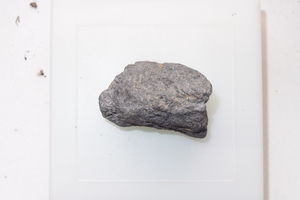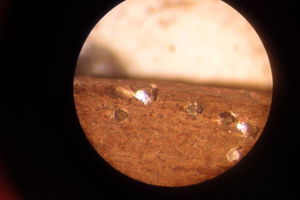Carbon
 Native carbon - graphite | |||||
 Small diamonds from grinding wheel | |||||
| General properties | |||||
|---|---|---|---|---|---|
| Name, symbol | Carbon, C | ||||
| Allotropes | Amorphous carbon, diamond, fullerene, graphene, glassy carbon, graphite, nanotubes, pyrolytic carbon | ||||
| Appearance |
Clear (diamond) Black or dark gray (all others) | ||||
| Carbon in the periodic table | |||||
| |||||
| Atomic number | 6 | ||||
| Standard atomic weight (Ar) | 12.011 | ||||
| Group, block | (carbon group); p-block | ||||
| Period | period 2 | ||||
| Electron configuration | [He] 2s2 2p2 | ||||
per shell | 2, 4 | ||||
| Physical properties | |||||
| Black, gray, transparent | |||||
| Phase | Solid | ||||
| Sublimation point | 3915 K (3642 °C, 6588 °F) | ||||
| Triple point | 4600 K, 10,800 kPa | ||||
| Heat of fusion | 117 kJ/mol (graphite) | ||||
| Atomic properties | |||||
| Oxidation states | +4, +3, +2, +1, 0, −1, −2, −3, −4(a mildly acidic oxide) | ||||
| Electronegativity | Pauling scale: 2.55 | ||||
| energies |
1st: 1086.5 kJ/mol 2nd: 2352.6 kJ/mol 3rd: 4620.5 kJ/mol | ||||
| Van der Waals radius | 170 pm | ||||
| Miscellanea | |||||
| Crystal structure |
graphite: simple hexagonal diamond: face-centered diamond-cubic | ||||
| Speed of sound thin rod | 18,350 m/s (at 20 °C) (diamond) | ||||
| Thermal expansion | 0.8 µm/(m·K) (at 25 °C) (diamond) | ||||
| Electrical resistivity | 7.837·10-9 Ω·m (graphite) | ||||
| Magnetic ordering | Diamagnetic | ||||
| Young's modulus | 1050 GPa (diamond) | ||||
| Shear modulus | 478 GPa (diamond) | ||||
| Bulk modulus | 442 GPa (diamond) | ||||
| Poisson ratio | 0.1 (diamond) | ||||
| Mohs hardness |
1–2(graphite) 10 (diamond) | ||||
| CAS Registry Number | 7440-44-0 | ||||
| History | |||||
| Discovery | Egyptians and Sumerians (3750 BCE) | ||||
Carbon is a nonmetallic chemical element with symbol C and atomic number 6. It is well known for its numerous allotropes, including diamond and graphite and as being central to all life. Because carbon can easily form four single bonds, it is capable of forming a vast number of compounds, namely all organic compounds.
Contents
[hide]Properties
Chemical
Carbon is not very reactive at standard conditions. It will burn in oxygen, the grade of oxidation greatly depending on the allotrope used as well as particle size and oxygen concentration.
- C + O2 → CO2
It will reduce the oxides of metals low on the reactivity scale to pure element, and forms carbides with more reactive metals:
Carbon can also reduce carbonates to their metals and carbon dioxide:
Activated carbon, a form of amorphous carbon with an extremely high surface-area-to-mass ratio, is used as an adsorbent in gas masks and can be used as a catalyst for some chemical reactions.
Physical
Due to its valency, carbon is capable of forming many interesting allotropes. Historically there were only three well known allotropes (graphite, diamond, amorphous carbon), but over the years many more have been discovered and many more are hypothesized. Only the most important are described below:
- Graphite: One of the most common allotropes of carbon, it's black-grey, is a fairly good electrical conductor, but has low thermal conductivity. Because carbon has one of the highest boiling temperature, it can be used in electrical arc lamp electrodes. Under standard conditions, graphite is the most stable form of carbon. It will burn under strong oxidizing conditions, but it's not very reactive otherwise.
- Diamond: By far the most known allotrope of carbon. A transparent material, it's the hardest known natural mineral, has the highest thermal conductivity of any known natural material, but unlike graphite, it's an electrical insulator. It is much more resistant to chemical attack than graphite.
- Amorphous carbon, which has a less defined structure than other forms, is black in color, and is much more reactive than the other allotropes. It is the largest component of some organic pyrolysis products such as charcoal.
- Glassy carbon, also known as vitreous carbon, is a non-graphitizing carbon which combines glassy and ceramic properties with those of graphite. Similar to graphite, it's a good electrical conductor and it's used as electrodes in electrochemistry and as high temperature crucibles.
- Pyrolytic carbon is an artificial form of carbon, similar to graphite, but with some covalent bonding between its graphene sheets as a result of imperfections in its production. It displays cleavage, like mica. This material has some unusual properties, like being more thermally conductive along the cleavage plane than graphite and being strongly diamagnetic, capable of levitating in a magnetic field.
- Fullerenes are molecules composed of carbon, in various forms such as hollow spheres (buckyballs), tubes (nanotubes), etc. They're of little importance to the amateur chemist, but are often studied in physics due to their special properties.
- Graphene forms nearly transparent sheets, only a single atom thick, of carbon atoms. It is 100 times stronger than steel and is an excellent conductor or both electricity and heat.
Availability
Graphite can be either bought from stores, extracted from carbon batteries, or simply reusing old graphite electrodes.
Diamond powder can be bought from stores that sell abrasive materials and larger stones, though it is quite expensive.
Amorphous carbon can be made from a variety of sources, such as dehydrating sugar with conc. sulfuric acid, scraping the black powder that forms when reducing copper salts with steel (though it should be washed with acid to remove the black copper oxide), pyrolyzing sugar, etc.
Glassy carbon can be bought online as electrodes.
Preparation
Charcoal that has been crushed and leached with boiling water, or coke prepared in a similar way are sufficient for most uses of carbon.
Amorphous carbon can be made by dehydrating sugar with sulfuric acid. Once it has been washed of excess acid, this is a very pure form of carbon.
Diamond powder can be made by passing electrical current through graphite for a long period of time. Larger diamonds cannot be feasibly made in a nonindustrial setting.
Buckyballs are present in soot, though the percentage is insignificant. Commercially, they are prepared by extraction of the pyrolysis products of aromatic compounds, or by an arc discharge between two graphite electrodes.
Projects
- Various pyrotechnics and energetic materials, such as black powder
- Carbothermally reduction of metal oxides
- Produce carbon monoxide from hot carbon and water
- Produce elemental phosphorus from carbon and phosphoric acid or from carbon, a phosphate salt, and silicon dioxide
- Electrolysis (graphite and glassy carbon electrodes)
- Demonstration of diamagnetism (pyrolytic carbon)
- Make an arc furnace (graphite and glassy carbon)
Handling
Safety
Pure carbon has extremely low toxicity to humans and can be handled and even ingested safely in the form of graphite or charcoal, and USP charcoal is used for treating various medical conditions.
Inhalation of coal dust or soot (carbon black) in large quantities, however, can be dangerous, as it irritates lung tissues and causes various congestive lung diseases. Powdered diamond is highly abrasive, and proper protection must be worn when working with it.
Storage
No carbon allotrope requires any special storage. Amorphous carbon, however, if it has high specific surface area, may adsorb gasses from the air, such as volatile organic compounds (VOC) or acidic vapors which will lower the purity of the carbon. It is best stored in tightly sealed containers.
Disposal
Amorphous carbon can burn in an oxidizing atmosphere, but the other carbon allotropes burn only at high temperatures. Carbon traces from various glassware can be cleaned either with aqua regia or piranha solution. No common carbon allotrope poses any threat to the environment, so no special disposal is required when discarding carbon waste and may be dumped in trash. Used industrial graphite electrodes may be contaminated with heavy metals and should be taken to disposal centers.